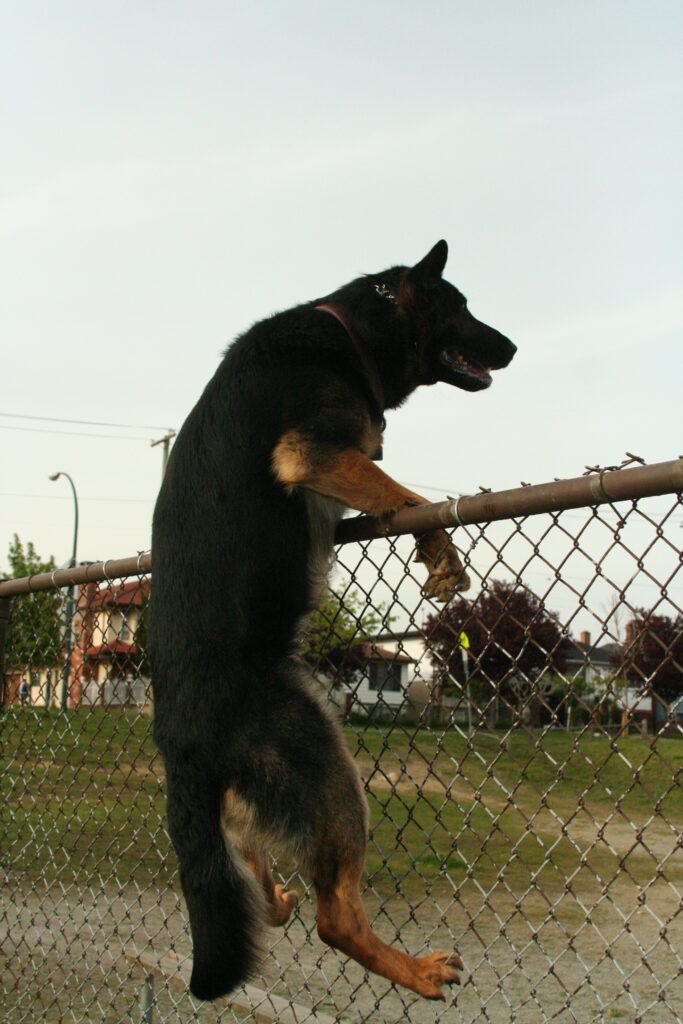The best type of fence for dogs is one that will keep your dogs safe and inside your property, which means it will vary based on the size of your dog, breed, and most importantly, behaviour. This goes without saying, but the vast majority of dogs act differently without supervision–and leaving a dog unattended in a yard is a recipe for disaster no matter what fencing solution you decide to go with.
We’ve dealt with our fair share of backyard escape artists, and based on our experience, a properly erected, well-maintained wooden panel fence of at least 6′ in height will do an adequate job of keeping your dog inside your property while he does his business–provided he is under supervision and is properly trained!

The last part is crucial, because until you know what your dog is capable of, you will have no idea whether he can clear that height or not. 6′ is the absolute minimum and is usually allowed in most jurisdictions–but if you can erect a taller fence, we definitely recommend going as high as you’re allowed. This is even more true if you have a working, sporting, or herding breed with long limbs and lots of energy. As you can see below, our old dog Liam cleared a 9′ fence with absolutely no trouble!




Why do we recommend a wooden fence over a wire fence? Well, even though they’re pricier to install and absolutely require frequent maintenance to prevent rotting, it creates a visual barrier for your dogs–which will go a long way in preventing them from attempting to escape in the first place. What do we mean by that? Well, imagine that your dogs are chilling out in the yard, and then a squirrel shows up on a tree in the next house. With a wooden panel fence, the squirrel’s movement won’t trigger your dog’s prey drive as much, and they might not even notice the squirrel at all. This goes the same with other wildlife, cats, or dogs–especially dogs walking with their owners on the street. All of these distractions are easily seen through a wire fence, and many dogs will try to bite at the wire or find a weakness in it in order to get out and chase/greet the intruder on the other side!
Furthermore, it’s easier to see defects on wooden fences. You wouldn’t miss a giant hole in a wooden fence. The same can’t be said for wire fences. From our years of experience in dog ownership, we’ve seen the sight below far too often.

Improperly installed wire fences can also create gaps underneath the fence that a dog can easily just dig under. We’ve even seen a smart old bitch lift the wire fence up with her teeth, scoot underneath, and then pull it back down! Let’s not forget that the holes in the wire also provide convenient footholds.
Speaking of digging, you can definitely install wire barriers underneath the fence (whether you have a wooden or wire one) that goes down into the soil to deter diggers–particularly important if you have nice, soft garden soil around your property.
We don’t recommend electric fences as a sure-fire way to keep dogs in. The main reason being that if you have a dog that you feel you need an electric fence for in order to keep them inside, they likely have the temperament that will get them to ignore the shock, at least momentarily, in order to get out.
The best fence for your dog is the one that keeps them safe inside your property! If you need any help, give us a call at 604 721-2391 and together we can find the best solution for your beloved best friend. You can also check out or fence section here!
Need ideas? You can always browse your local home and hardware store like Home Depot!

